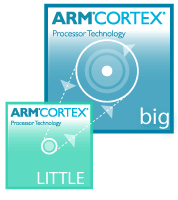 At the ARM TechCon conference in Santa Clara this week, ARM unveiled the Cortex-A35 architecture, its most power-efficient 64-bit processor design to date. Cortex-A35 draws about 33 percent less power per core and occupies 25 percent less silicon area, compared to the 64-bit Cortex-A53, says ARM. The SoC is aimed primarily at the smartphone market, but can also be used for “power-constrained embedded applications such as single-board computers and automotive,” says the chip designer.
At the ARM TechCon conference in Santa Clara this week, ARM unveiled the Cortex-A35 architecture, its most power-efficient 64-bit processor design to date. Cortex-A35 draws about 33 percent less power per core and occupies 25 percent less silicon area, compared to the 64-bit Cortex-A53, says ARM. The SoC is aimed primarily at the smartphone market, but can also be used for “power-constrained embedded applications such as single-board computers and automotive,” says the chip designer.
Due to ship in smartphones and other devices in late 2016, the ARMv8-A based Cortex-A35 is presented as a replacement for the 32-bit Cortex-A7. Cortex-A35 chips, which will also support 32-bit mode, will be 20 percent faster than Cortex-A7 on 32-bit mobile workloads “while consuming less than 90mW total power per core when operating at 1GHz in a 28nm process node,” says ARM.
Acccording to ARM, more than half of all shipping smartphones now use 64-bit, ARMv8-A SoCs, which range from quad-core Cortex-A53 models to octa-core -A53 and -A57 SoCs. By contrast, Cortex-A7 is found mostly in low-end smartphones, or mid-range phones combined with Cortex-A15 or -A17 cores.
Like all these architectures, Cortex-A35 supports ARM’s Big.Little multi-core task sharing technology, permitting similar hybrids, most likely in combinations with Cortex-A57 or Cortex-A72 cores. In fact, AnandTech suggests that Cortex-A35 is as much the heir to the Cortex-A53 as it is the Cortex-A7. Since much of the duty of the lower-end cores in Big.Little SoCs is to offer more power-efficient operation when doing less demanding work, the -A35 could offer a big power savings over the -A53 in Cortex-A57 or Cortex-A72 driven combo SoCs.
The confusion over which SoC is the heir to which is nothing new. ARM called the 32-bit Cortex-A17 the heir to the Cortex-A9, but it was widely seen — and often used — as a replacement for the Cortex-A15. Previously, ARM had called the widely ignored Cortex-A12 the heir to the Cortex-A9, as well.




